SUPPORTING CITY KNOW-HOW
Human health and planetary health are influenced by the urban environments we have created. For both human and planetary health, trends showing a current decline and ongoing risks are leading to increasing concern globally. It is imperative that finding solutions becomes a core focus for urban policy. This will require concerted action. Cities & Health is dedicated to supporting a multidirectional flow of knowledge to help make this happen. We wish to foster conversations between researchers, practitioners, policy-makers, communities, and decision-makers in cities. This is the purpose of this section, with its short ‘City Know-how’ policy briefings of research findings. The team at Cities & Health, and our knowledge partners (International Society for Urban Health and SALUS.Global), invite you to join their networks, and contribute to the conversations we so urgently need. We call out to communities, researchers, practitioners and policy-makers to consider publishing in Cities & Health to help influence urban policy.
This special issue of Cities & Health comprises our second collection of articles focussing on COVID-19 – the lessons we need to learn.
In this issue you will find a leading editorial, followed by eight commentary articles, including one about how case study published in this issue of Cities & Health has been used in the ‘Hon’ble Delhi High Court’. Following that we publish a response to Biglieri et al. ‘City as the core of contagion?’ With the authors’ reply.
Finally, a rich research section comprises a reflective think-piece and six empirical articles; including papers from Switzerland, England, Canada, Northern Ireland and Finland. The findings from each research paper have been distilled in this article, presented as short ‘City Know-how’ briefings. The section opens with three previously unpublished briefings from papers in our first COVID-19 special issue ‘Cities, health and COVID-19: initial reflections and future challenges’.
We invite you to scan this wealth of content. There are many shared urban problems, however there are many solutions being tested, and others waiting to be discovered.
Let’s keep learning from the crisis of COVID-19 to make human settlements healthier and more equitable for communities, and healthier for the planet. We welcome contributions from all readers. These may be conjecture, commentary and debate, city reports or your own case studies.
The ways in which COVID-19 could (and should?) change city building
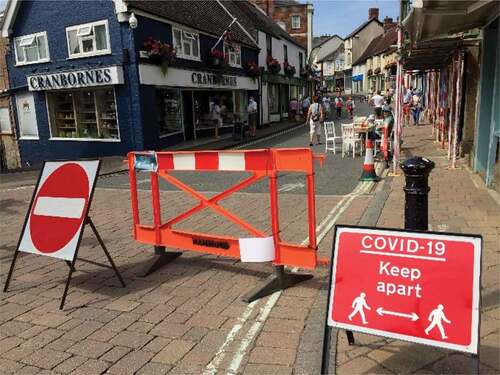
How will COVID-19 change our relationship with public space and the future of city design? We outline the key ways in which city planning and the design of public space may change as a result of the COVID-19 pandemic.
For the attention of: Managers of public space. City planners, urban designers, landscape architects and architects in Europe and Latin America and North America and Australasia. Lead urban designers in city government.
The problem: COVID-19 is changing how we use public space and this may have lasting consequences for our cities. Many conjectures, predictions and hypothesis are being made, but the future is highly uncertain. While it is too early to predict how city design will change, it is urgent to begin to outline the key dimensions of this discussion and consider how built environment related professions and practice will need to change or adapt.
What we did and why: We reviewed many of the ways in which cities might be adapting to the COVID-19 crisis with a focus on public space – use, design and management. While it is too early to predict how city design will change, it is worthwhile to begin to outline the key dimensions of this discussion and consider how our profession and practice will need to change or adapt.
What our study adds: We summarize the main ways in which the COVID-19 crisis might change our relationship with public space. We think beyond the current measures to consider which changes will stay with us once the immediacy of the pandemic has passed. The size, scope and speed of the crisis make it feel like we are living through a profound transformation. It is as if we are experiencing a tectonic shift, where the ground is moving beneath us, changing the fundamental principles and rules that have governed our practice. Will 2020 define a before and after in planning and design?
Implications for city policy and practice: While there are many potential impacts of COVID-19 on land use, urban density, telecommuting, energy, transportation, retail, and so forth, our focus is on how the current pandemic may change public space. Our list of emerging questions is extensive but not exhaustive. We do not have all the answers now. As a result, we will need to observe, measure and reflect on changing patterns in the use of public space. Things are moving fast.
We identify important questions emerging from our experiences of the COVID-19 episode that may change the ‘Use, Behaviour and Perceptions’ (nine questions) and ‘Design’ (five questions). We pose another five questions for inequities and exclusion:
● How will the needs of vulnerable groups such as racial minorities, immigrants, women, the poor, elderly, children, disabled and the homeless be accounted for in future public space designs, practices, and rules?
● Will cities in the Global South attempt to constrain further or regulate the informal street economy?
● Will COVID-19 change who moves in and who moves out of newly redeveloped urban centers?
● Will everyone be able to shift to active transit?
● Will the pandemic permanently disrupt the interconnected global settlement system and freedom of movement?
For further information:
Urban Planning, Environment and Health at The Barcelona Institute for Global Health, ISGlobal. An aim is to strengthen the connection between the health of the population and the environment as the foundation for urban planning.
Barcelona Lab for Urban Environmental Justice and Sustainability. The Lab develops research on environmental justice and sustainability that builds on urban planning, policy, and studies in social inequality and development.
Full research article: The impact of COVID-19 on public space: an early review of the emerging questions – design, perceptions and inequities by Jordi Honey-Rosés, Isabelle Anguelovski, Vincent K. Chireh, Carolyn Daher, Cecil Konijnendijk van den Bosch, Jill S. Litt, Vrushti Mawani, Michael K. McCall, Arturo Orellana, Emilia Oscilowicz, Ulises Sánchez, Maged Senbel, Xueqi Tan, Erick Villagomez, Oscar Zapata & Mark J Nieuwenhuijsen.
How did people use Frankfurt Mainkai riverfront in Germany during a road closure experiment and coronavirus lockdown?
People using the open Mainkai street after road closure. Photo: B. Fonte.
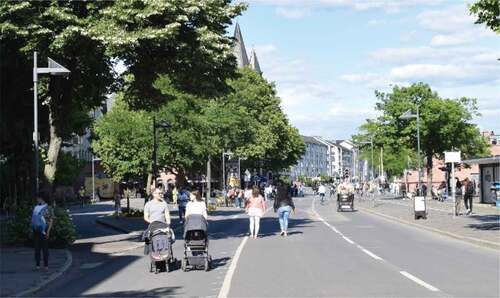
Year-long road closure to Mainkai riverfront in Frankfurt demonstrated more active public space usage, especially during COVID-19 lockdown. Our study looks at the +45% cyclists, +20% pedestrians and + 1150% children cycling on the street.
For the attention of: Policy makers for streets and the public realm, Planning departments, Citizens, Public health inclusion and physical activity teams.
The problem: The pedestrianization of northern Mainkai riverfront in Frankfurt brought the ongoing vehicular traffic to a halt and encouraged people to use the open street space. The experiment was discussed controversially in public and among policy makers. With the temporary experiment coming to an end in August 2020, the future of the Mainkai riverfront was in question.
What we did and why: The one-year-long experimental closure of the Mainkai street provided a rare opportunity to study an in situ urbanism ‘laboratory for change’ and impact on the public space usage. We studied diverse spaces by collecting peak hour pedestrian data, analyzing active spaces for children and observing stationary activities before the road closure during July 2019 and May 2020. This adds a qualitative perspective from eye level and captures possible effects on active mobility, accessibility and well-being.
What our study adds: Our study underlines related initiatives world-wide that traffic calming acts as a catalyst for safer and healthier urban environments. Under the strictures of the coronavirus pandemic lockdown restrictions, the study suggests that (temporary) road closure to cars is a key element in changing the quality of public space to attract different user-groups and cater for an increased need to become physically active and engage socially, while in this case also keeping distancing rules.
Implications for city policy and practice: Based on our study, we recommend to implement and extend the road closure experiments and their timelines during pandemic restrictions, as more people (especially children who were observed cycling) use the open public spaces showcasing a safe and healthy environment. Other ‘natural’ situations should also be sought during which natural experiments can be conducted.
For further information this and other elements of our work: Urban Health Games Research Group our website presents many other projects too, it is in German with English translation available.
Full research article: How do people use Frankfurt Mainkai riverfront during a road closure experiment? By Lakshya Pandit, Gladys Vasquez Fauggier, Lanqing Gu & Martin Knöll
Improvements to urban planning and public policy: lessons from the responses COVID-19 in Ghana
Pandemic Transformations Agenda. Source: ©Joe Ravetz (CC BY-NC-SA 4.0).

The global COVID-19 pandemic, with its associated issues of isolation, enhanced hygiene practices and contact tracing brought up a number of issues to the public domain, many of which bordered on the nexus between urban planning and public health. We examine how new ideas concerning the linkages between urban planning and public health revealed by the COVID-19 crisis can be integrated into practice and how we might leverage this knowledge to build more just, healthier and liveable cities.
For the attention of: City leaders and city planners in low- and middle-income countries
The problem: We expose serious structural problems in the housing, transport, health and water, sanitation and hygiene sectors. These structural weaknesses inhibit the efficiency of the urban systems whilst at the same time limiting the ability of policy makers to effectively respond to pandemics such as COVID-19.
What we did and why: We used Ravetz’s framework on ‘nexus of syndromes and connexus of synergies’ between various elements of public life (see FFI below). This allowed us to explore inter-related policy failures/successes in Ghana that contribute to poor public health and lack of pandemic preparedness, particularly as they relate to social, technological, economic, ecological, political issues for COVID-19 and future pandemics. Through reviewing pandemic responses in public policy, we observed that current urban planning in Ghana leaves many people behind and exposes the lives of many to current and future disease pandemics.
What our study adds: Planning has been variously defined as the link between knowledge and action, the guidance of future action, storytelling about the future and expectation management. We shows that there have been many successes and failures with regards to the public policy responses to the COVID-19 pandemic. Our analysis highlights the importance of urban planning agenda that intensifies collaborative working with public health departments (and other agencies) to safeguard collective efforts in dealing decisively with public health emergencies.
Implications for city policy and practice: We propose an agenda for transformation which revolves around the co-evolution and co-creation of new forms of societal values that are less materialistic and individualistic but rather more egalitarian.
In response to the COVID-19 pandemic, the effective collaboration between the private, academic institutions and the public sector should serve as the strategic basis for improving Ghana’s health sector and other sectors of the economy. We recommend the need for a new urban planning agenda that integrates health in urban planning and harmonises various elements and drivers of urban life.
For further information: For further details of the concepts involved see Joe Ravetz’s paper ‘Pandemic 3.0 from crisis to transformation: exploring the COVID-19 challenge’, online in Journal of Future Studies (2020). Our diagram is reproduced from that paper.
Full research article: Urban planning and public policy responses to the management of COVID-19 in Ghana by David Anaafo, Ebenezer Owusu-Addo and & Stephen Appiah Takyi
How did the first wave of COVID-19 affect the kind of dwelling residents consider as ideal? A study from Switzerland
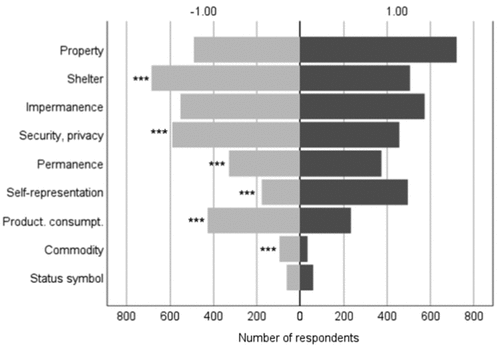
During the first wave of COVID-19, homes were tasked with simultaneously providing manifold city services and functions. How did the pandemic affect the kind of dwelling that Swiss residents consider as ideal?
For the attention of: National and local level decision makers; Practitioners and professionals (e.g. architects, urban planners); Housing providers; Residents.
The problem: During the first wave of COVID-19, our homes were tasked with simultaneously providing manifold services and functions (e.g. working, studying, doing sports). This revealed deficiencies in our dwellings, through the increased time spent at home, such as lack of comfort, increased energy usage. Proposed requirements to address these were, for the most part, formulated using a linear top-down approach which disregarded potential changes in residents’ preferences during the confinement. Studying the effects of COVID-19 on housing required a systems perspective, which recognized people as agents who have agency to change their environment for their own health and wellbeing.
What we did and why: We investigated the effects of the first wave of COVID-19 on residential preferences in Switzerland using an online survey of 5378 residents. We adopted a ‘systems perspective’, whereby changes in the functions assigned to ideal dwellings are be observed in relation to other elements of the housing system, and in particular occupants’ characteristics, changes in leisure activities, and the conditions of their environments (physical, social, legal, economic).
What our study adds: Our results show that for the majority of respondents (60%) the ideal function changed during the confinement. The most relevant changes concerned the increased desire for a place of ‘self-representation’ and the decreased desire for a place for ‘production, consumption’. This finding shows that maintaining healthy environments during a confinement means providing access to more than four walls and a roof; it also means responding to sociocultural needs for which our dwellings are unprepared to provide alternatives (e.g. cultural activities, social interactions).
Implications for city policy and practice: Architects, housing providers and policy makers are responsible for ensuring that housing is compatible with and enhances access to a wide variety of experiences, resources, contacts and interactions while containing the virus spread. This can be achieved via the provision of shared but individually rented spaces in residential buildings (e.g. for music or teleworking), or via the design of private but visually interconnected external spaces such as balconies for safe community interactions (e.g. from balcony to balcony, from street to balcony).
In particular, we urge housing stakeholders to acknowledge the increasing need for housing as a place for self-representation and consider the added value of empowering inhabitants to respond to this design challenge.
For further information:
Corona Citizen Science: A research on the COVID-19 experience in Switzerland.
Citizen Think Tank: Mon logement à l’épreuve du confinement: Quelles orientations pour l’après?
Swiss Corona Citizen Science: A collaborative investigation on housing conditions and wellbeing in times of COVID-19 containment: exploring the social effects of the crisis and co-creating sustainable post-crisis futures.
Full research article:
How the first wave of COVID-19 in Switzerland affected residential preferences by Anna Pagani, Livia Fritz, Ralph Hansmann, Vincent Kaufmann & Claudia R. Binder
How is our wellbeing affected by the design of our homes: lived experiences during COVID-19 in London, England
The home in lockdown: work, eat, live, play, sleep, and learn. Photo: The Laboratory for Design and Machine Learning.
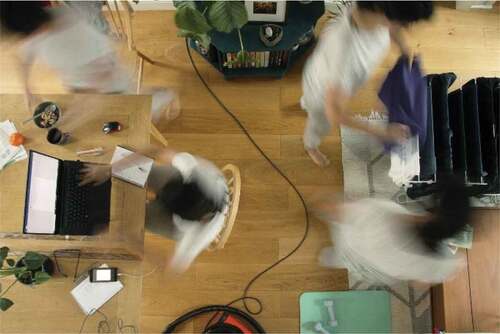
How has the pandemic changed how we use and perceive our home? Many were working, eating, living, playing, sleeping, and learning in the same space. Has changed perceptions influenced ideas of the design of our homes, and potential for happiness and wellbeing?
For the attention of: Those responsible for regulating minimum space standards and housing regulations, such as government departments with responsibilities for housing or health, and city mayors.
The problem: While there is substantial research on how a lack of space and poor-quality housing adversely affects wellbeing, stronger evidence is needed to determine internal space standards and support in making them mandatory. In England, current minimum space standards are based on numerical values and fail to acknowledge a broader more inclusive range of uses and activities of the home.
What we did and why: We conducted online survey and semi-structured interviews with London residents in 2021. We wanted to understand how people used and experienced their home and how this might have changed during the COVID-19 pandemic. We were interested in what changes people had made to better meet their needs, and how the quality and design of their domestic space affected their physical and mental wellbeing. This research aims to address the evidence gap between wellbeing and architectural design.
What our study adds: We found how people’s wellbeing was affected, both positively and negatively, due to the design and quality of their homes:
● The agency to make changes at home mattered.
● Changing socio-spatial relationships led to a shift in understanding issues such as privacy and safety.
● Dwelling size became even more problematic during the lockdowns.
● Perceptions and dwelling preferences changed for many participants. Many had not previously been aware of the effect of design and quality of their homes on their wellbeing.
Implications for city policy and practice: To improve housing quality and design, the following policy recommendations should be considered:
● Making minimum space standards mandatory across all tenures and sectors and giving greater flexibility in the distribution of floor space to meet them.
● Adding to the existing technical evidence though studies focussing on lived experiences and actual use of home.
● Acknowledging the need to include a wider range of home uses and household compositions for housing provision and design standards.
● Making access to outdoor space compulsory.
For further information: Laboratory for Design and Machine Learning – The Home, the Household, and COVID-19
Full research article: The impact of housing design and quality on wellbeing: lived experiences of the home during COVID-19 in London by Lucia Alonso & Sam Jacoby
Walking eases everyday life in a pandemic city, Helsinki, Finland
Images from ‘corona walks’ in the early weeks of the pandemic, Helsinki, March 2020. I noticed that I had started walking at more irregular hours to avoid other people and I also paid far more attention to how the spring advanced in my neighbourhood. Credit: The author.

Walking is a forgotten aspect of urban communication. Walking provides places of interaction and is revealing of the relationship between citizens and politics.
For the attention of: Urban planners, traffic planners, municipal politicians.
The problem: In March 2020 the pandemic started to grip Helsinki, Finland. Public commentaries by journalists, researchers and politicians predicted that urban growth will take a halt and people will flee the city, looking perhaps for permanent housing elsewhere. From the beginning of the spring urban green areas were becoming crowded with pedestrians, at previously unseen hours. However, no planning interventions were made to enhance pedestrians’ space to walk.
What I did and why: I was interested in how young adults living in the most densely populated parts of eastern downtown Helsinki related to their lived environments and the new-found pastime of walking. Which places would be attractive when commercial services were closed and other people in the streetscape may be seen as threats? How was the question of mobility and exceptionality of urban life solved amongst this group of capable and urban-savvy residents?
What our study adds: This study adds knowledge on pedestrians’ tactics to shape the environment to their needs. The qualitative interviews, survey and instant messaging group data demonstrates the types of meanings urban space gains in a time of high exceptionality in urban life. The study also examines the relationship between the urban citizen and the political-governing dimension of the city, namely urban planning. The study shows how mediated representations of walking impact people’s behaviour and sentiments in public space.
Implications for city policy and practice: Walking presents as a sensorially and emotionally sensitive subject matter in which walking should be looked at from the point of view of connection, motility and spatial justice. Although a certain degree of centralization of communication in a crisis situation is necessary, my study argues that municipalities can take an active role in campaigning for safe urban walking and alternative walking routes, even if no planning interventions are made.
Full research article: Walking as urban communication: affordances and agency in public space in a semi-lockdown city by Annaliina Niitamo.
The neighbourhood built environment and outdoor physical activity during the COVID-19 pandemic
Closed neighbourhood playground in Calgary, Canada, during the COVID-19 pandemic Photo: Gavin McCormack, April 28 2020.
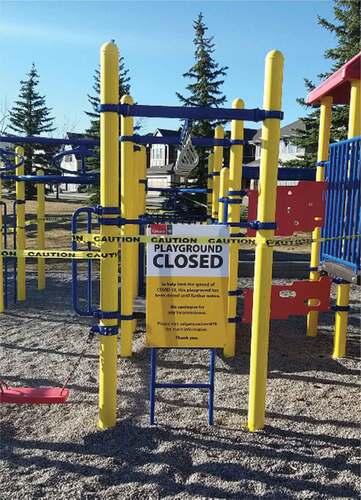
Public health authorities encourage outdoor activity while physical distancing during the pandemic, but could the built form of cities and neighbourhoods support outdoor activity during COVID-19?
For the attention of: Public health authorities and practitioners; City and municipal planners and policy-makers; Transportation and urban planners; Recreational departments and services; Parks departments and services; Urban residents and workers.
The problem: The public health emergency response to control the COVID-19 pandemic has included physical distancing and the closure of educational and day care facilities, non-essential businesses, and private and public recreation facilities (e.g. playgrounds, outdoor exercise equipment, sports fields and courts). Outdoor activity is recommended for people to maintain their physical activity routines during the pandemic. There is a dearth of evidence about how the built environment has supported or hindered outdoor activity during the pandemic.
What we did and why: We undertook a qualitative study to explore the built environment’s role in supporting outdoor activity during the early stages of the pandemic in Canada. Our study was undertaken in Calgary (Alberta, Canada). Between June and October 2020, we conducted semi-structured, in-depth interviews to capture the perspectives of 12 adults (6 men and 6 women) about how their neighbourhood environment supported outdoor physical activity during the pandemic. Interview data were analysed to identify common themes.
What our study adds: We found that:
● Parks, pathways, and sidewalks supported outdoor activity during the pandemic.
● Outdoor walking, running, and cycling were commonly reported activities.
● Risk of COVID-19 exposure informed decisions regarding park and pathway use.
● Under-utilized greenspace may provide space for safe physical activity programs.
● Outdoor space facilitated social interaction and physical activity.
Implications for city policy and practice:
Neighbourhoods should include well connected pathway systems that allow for sufficient physical space between users and parks and greenspace large enough to avoid crowding and to facilitate physical distancing.
Encouraging physical activity during pandemics might also be facilitated through safe recreational programming (e.g. with masking and physical distancing) in under-utilized greenspaces such as sports fields.
The built environment in important for supporting the maintenance of physical activity during the current and future infectious disease pandemics.
For further information on our work visit Built Environment and Healthy Living Lab. Our aim is to improve the health and wellbeing of populations through neighbourhood built design. We generate causal evidence for policymakers and practitioners to create built environments that support and promote health for all individuals regardless of their sociodemographic circumstances.
Full research article: Neighbourhood environment facilitators and barriers to outdoor activity during the first wave of the COVID-19 pandemic in Canada: a qualitative study by Gavin R. McCormack, Jennie Petersen, Calli Naish, Dalia Ghoneim & Patricia K. Doyle-Baker.
The effect of COVID-19 on parks and greenspace use; understandings from self-reported data, Southwestern Ontario, Canada
Images of Waterloo parks and greenspaces, Canada. Photos: The authors.
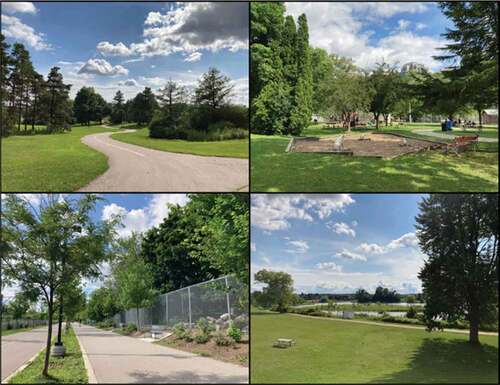
How did parks and greenspace use change three months into the pandemic? Parks and greenspace can help mental health, but also may be sites of virus transmission.
For the attention of: Public Health officials; Parks and greenspace planners; Urban citizens
The problem: The COVID-19 pandemic has radically altered the risks associated with public space. Because the virus is socially communicable, members of the general public may avoid public space. Yet, public spaces such as parks and greenspace provide stress restoration benefits that are important during times of crisis. As such, it is unclear whether the general public is visiting parks during the pandemic more or less often than before the pandemic.
What we did and why: In this study we examined how the pandemic affected the general public’s patterns of behaviour in public space within a region in Southwestern Ontario. We explored whether the frequency of, as well as reason for, visiting parks or greenspace was self-reported as to have changed as a result of the pandemic. We also investigated whether demographic variables of age, gender, income, education, household density, household type, and city of residence predicted change in park and greenspace use.
What our study adds: Our his study demonstrates a significant decrease in park and greenspace use three months into the pandemic. Change in frequency of park and greenspace visitation was significantly predicted by gender, reason for visitation, number of people in household, and income. Regarding these effects, it is speculated that the perception of COVID-19 transmission risk overrides the perceived stress restoration benefits of parks and greenspace.
Implications for city policy and practice: Given the unprecedented effect the pandemic has had on population-level indices of mental health, consideration should be given to facilitating access to parks and greenspaces. This is particularly true for spaces that facilitate physical activities. Future research should investigate the motivational differences between genders, ages, and income levels, so that all members of the public are equitably supported by parks and greenspaces infrastructure during and after the pandemic.
For further information available at: Urban Realities Laboratory: We study the impact of urban design on human psychology. We employ a variety of methods from field studies of behaviour in urban and architectural settings to the use of immersive virtual reality to test predictions about urban behaviour in simulations.
Full research article: The effect of COVID-19 on parks and greenspace use during the first three months of the pandemic – a survey study by David Borkenhagen, Emily Grant, Robin Mazumder, Hanna R. Negami, Jatheesh Srikantharajah & Colin Ellard
Impact of COVID-19 on neighbourhood physical activity in older adults, a study from the UK
Our thematic framework used to determine commonalities in the survey responses.
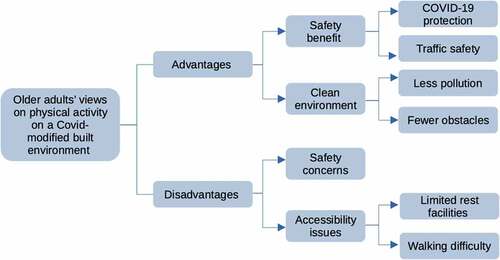
Older adults exercised less during COVID-19. Covid-related built environment modifications such as one-way walking systems and social distancing may have made physical activity more difficult.
For the attention of: Healthy ageing communities and campaigns. City planners and urban designers.
The problem: Physical activity is important to maintain older adults’ health, wellbeing, and independence, and this was particularly important during the coronavirus (COVID-19) pandemic. To slow the spread of COVID-19, built environment modifications were introduced in public areas such as one-way walking systems to enable social distancing, public toilet closures, and outdoor seating limitations. These modifications were intended to encourage safe physical activity but could have made outdoor walking and exercise more difficult for older adults.
What we did and why: We investigated whether COVID-related built environment modifications reduced older adults’ physical activity and increased their fear of falling. To assess this, we created an online survey using both closed and open-ended questions. This survey was completed by 282 older adults aged 65 + .
What our study adds: We found older adults engaged in less physical activity during COVID-19, particularly those who were concerned about falling. Many older adults thought that COVID-related built environment modifications made exercise more difficult and created safety or accessibility issues, particularly public toilet closures. These built environment modifications were also associated with less physical activity.
We concluded that COVID-related built environment modifications made walking exercise more difficult, and possibly contributed to the reduced physical activity seen in older adults throughout COVID-19.
Implications for city policy and practice: We recommend that if similar modifications are required in the future, older adults’ needs must be better accommodated to avoid discouraging physical activity and compromising long-term health. This could include using roads to maximise the space available for walking, and prioritising safe access to public toilets and outdoor seating.
Full research article: Impact of COVID-19 on neighbourhood physical activity in older adults by Charlotte Hennah, Geraint Ellis & Michail Doumas
